Topology defines the structure of the network of how all the components are interconnected to each other. There are two types of topology: physical and logical topology.

Table of Contents
Bus Topology
The bus topology is designed in such a way that all the stations are connected through a single cable known as a backbone cable. Each node is either connected to the backbone cable by drop cable or directly connected to the backbone cable. When a node wants to send a message over the network, it puts a message over the network. All the stations available in the network will receive the message whether it has been addressed or not.
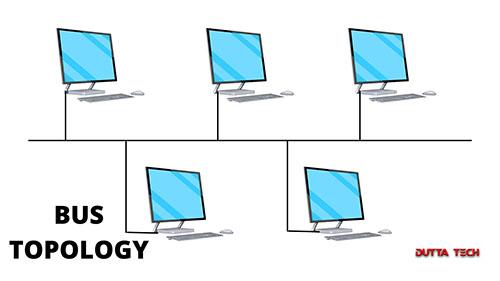
The bus topology is mainly used in 802.3 (ethernet) and 802.4 standard networks. The configuration of a bus topology is quite simpler as compared to other topologies. The backbone cable is considered as a “single lane” through which the message is broadcast to all the stations. The most common access method of the bus topologies is CSMA (Carrier Sense Multiple Access).
Ring Topology
Ring topology is like a bus topology, but with connected ends. The node that receives the message from the previous computer will retransmit to the next node. The data flows in one direction, i.e., it is unidirectional. The data flows in a single loop continuously known as an endless loop. It has no terminated ends, i.e., each node is connected to another node and has no termination point. The data in a ring topology flow in a clockwise direction.
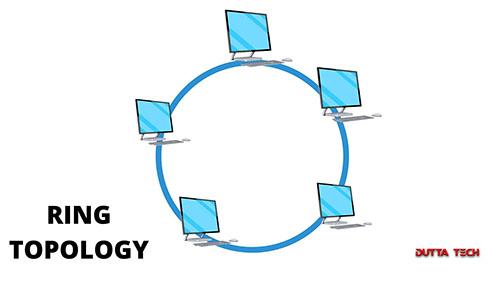
The most common access method of the ring topology is token passing. A token is a frame that circulates around the network. Token passing is a network access method in which a token is passed from one node to another node.
A token moves around the network, and it is passed from computer to computer until it reaches its destination. The sender modifies the token by putting the address along with the data. The data is passed from one device to another device until the destination address matches. Once the token is received by the destination device, then it sends the acknowledgment to the sender. In a ring topology, a token is used as a carrier.
Star Topology
Star topology is an arrangement of the network in which every node is connected to the central hub, switch, or a central computer. The central computer is known as a server, and the peripheral devices attached to the server are known as clients. Coaxial cable or RJ-45 cables are used to connect the computers. Hubs or Switches are mainly used as connected devices in a physical star topology. Star topology is the most popular topology in network implementation.

Tree Topology
A tree topology combines the characteristics of bus topology and star topology. A tree topology is a type of structure in which all the computers are connected with each other in a hierarchical fashion. The top-most node in tree topology is known as a root node, and all other nodes are the descendants of the root node. There is only one path that exists between two nodes for the data transmission. Thus, it forms a parent-child hierarchy.
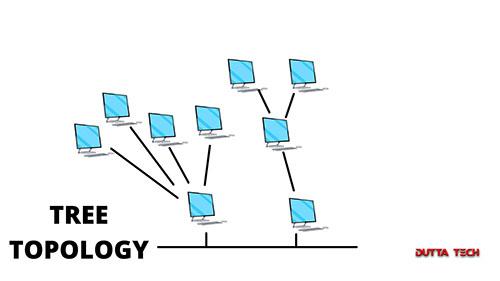
Mesh topology
Mesh technology is an arrangement of the network in which computers are interconnected with each other through various redundant connections. There are multiple paths from one computer to another computer. It does not contain the switch, hub, or any central computer which acts as a central point of communication. The Internet is an example of mesh topology. Mesh topology is mainly used for WAN implementations where communication failures are a critical concern. Mesh topology is mainly used for wireless networks.
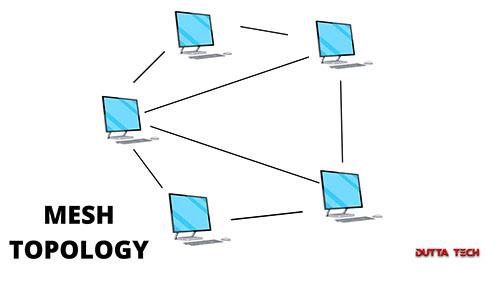
Mesh topology can be formed by using the formula:
Number of cables = (n*(n-1))/2;
Where n is the number of nodes that represent the network.
Hybrid Topology
The combination of different topologies is known as Hybrid topology. When two or more different topologies are joint together is called Hybrid topology. For example, if there exists a ring topology in one branch of the bank and bus topology in another branch of the bank, connecting these two topologies will result in a Hybrid topology.
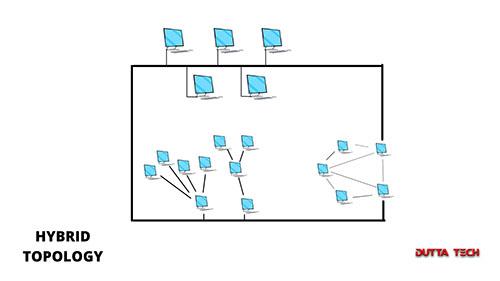
Advantages
- Reliable: If a fault occurs in any part of the network will not affect the rest of the network.
- Scalable: The size of the network can be easily expanded by adding new devices without any effect on the functionality of the existing network.
- Flexible: This topology is very flexible. It can be designed according to the requirements of the organization.
- Effective: Hybrid topology is very effective as it can be designed in such a way that the strength of the network is maximized and minimizes the weakness of the network.
Disadvantages of Hybrid topology
- Complex design: It is very difficult to design the architecture of the Hybrid network according to the environment.
- Costly Hub: The Hubs used in the Hybrid topology are very expensive in comparison to different from usual Hubs used in other topologies.
- Costly infrastructure: The infrastructure cost is very high in cost because of a lot of cabling, network devices, etc.
